

? | Home page | Tutorial | Recording




Before anything else, we need to prepare the recording session. We are not going to look for a melody, nor improvise or rehearse... we are going to properly record a song that we have already written. To avoid doing the same things over again each time I wish to record a song, I prepared a blank template which contains all the tracks and buses I need. I may naturally add or delete some elements if the template is not appropriate for the current project.
What does my template look like?
Track-wise:
- Rhythm guitar tracks (from 2 to 8 depending on the project)
- Solo guitar tracks (usually 2 tracks to make the sound thicker)
- Two bass tracks (one with the direct raw sound, and one with an amp simulation)
- Lead vocal tracks (usually one or two tracks, depends if I record it twice or not)
- Background vocals tracks (if the project demands it)
- Keyboard tracks (same thing, the number of virtual instruments will depend on the project, can be none, can be 5 or 6...)
Then we have drum tracks. There is one track per drum element. They are automatically created when I insert my virtual drum plugin:
- Kick drum
- Snare drum
- Low tom
- Medium tom
- High tom
- Hi-hat
- Crash cymbal
- Ride cymbal
- Splash cymbal
- Overhead microphone
- Room Ambiance microphone
- Piezzo microphone
- One MIDI track on which the drum score will be placed.
Bus-wise, I have one group for the guitars, one for the bass, one for the vocals, one for the drums, each of them is redirected towards the Master bus, which goes out throuh my studio monitors. It looks like this:

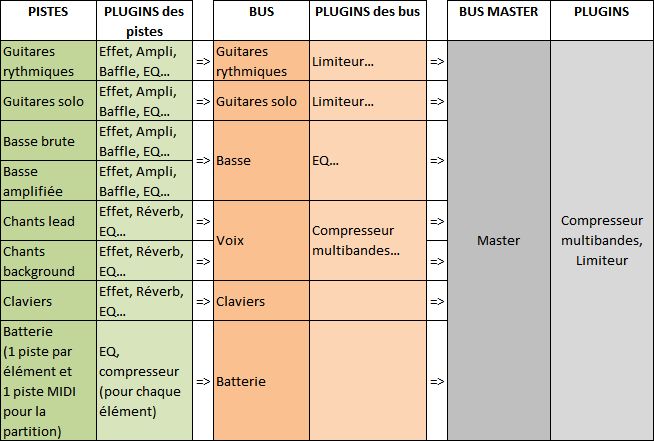





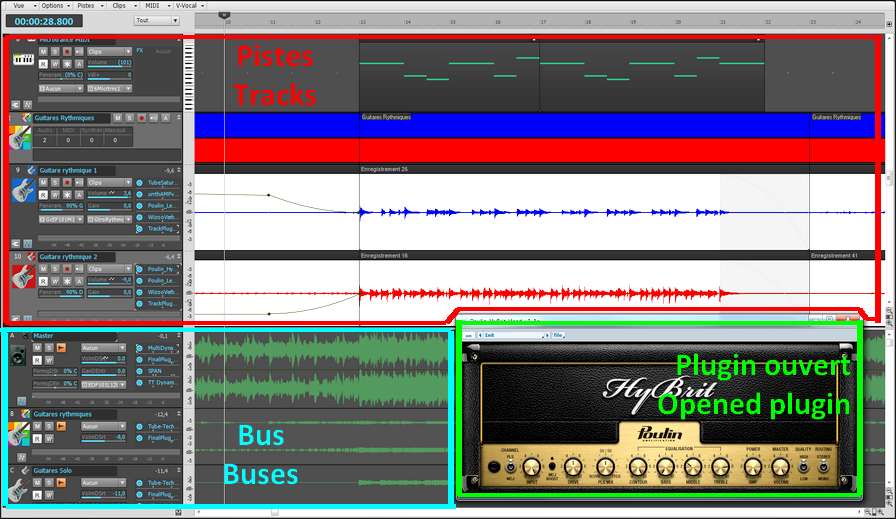


Recording an acoustic real drum kit is far from being easy, even for professional sound engineers. It a time-consuming process, it's frequent to spend several hours placing the microphones around the drum elements before you can actually record. But we are in a home studio, and we will have to deal with a software drum kit, based on midi files...
First of all, why start with the drums? The answer is simple, we will use drums as a metronome. The drums sound will guide us and help us follow the tempo. This will allow for an even recording and the song will not speed up or slow down unintentionally. Of course, variations can be interesting and bring some life to an otherwise mechanical tempo, but let's consider that a studio session seeks recording perfection, even though it's only a home studio.
I usually have no idea what my final drum track will sound like. Actually, I only adjust it when the rest of the song is finished. But I still need its metronome function to record all other instruments. Thus, I create a drum track which repeats itself over and over again, and I try to have this loop match what I am about to play (no punk rhythm to record a ballad). For instance, I'll use one of these patterns:
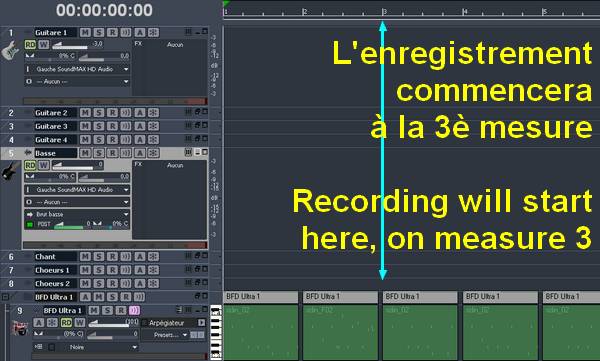

Let's not forget we are recording in a home studio, in an appartment and it is simply impossible to play with a good old 100-watt tube amplifier, without the neigbors calling the police. So we are going to have to record the guitars and the bass directly through the audio interface. No real amplifier, no microphones involved. The latter solution would be preferable, but on of the benefits of direct recording, coupled with amplifier simulators, is that you can always edit the sound later, without having to re-record. Just change the settings and you're done.
So now... bass or guitars first? There isn't one clear answer. Bass and drums are the foundation, the rhythm base of a song and everything else should rely on them. But other factors could also be taken into consideration: for instance, the person recording may be more comfortable with a guitar than a bass, and will rather play guitar first. Or maybe the song has a very important bass riff that compels you to record it first. In any case, you are the one who can decide. If you are uncertain, then the drum / bass duo is a safe bet. If this is in place, then the rest can easily be added.
Guitar or bass, the recording process will be the same. Plug your guitar into the pre-amp, the pre-amp is connected to the audio interface (or plug your guitar directly into the audio interface if using the interface's pre-amp), and set the recording level. This is very important! Before recording anything, check that you are not going to go beyond the maximum level (0 dB, zero decibel). In a home studio, you won't have a sound engineer besides you to make adjustments on the fly, while you are playing. You are the one to take precautions. How can you do that? Simple: try and adjust, it doesn't take long and will prevent you from making a perfect take, then realize the levels were too low or too high, forcing you to do it all over again.
Have a try: for a rhythm guitar for example, play the loudest parts and set the preamp and audio interface volume levels in such way that when you play the loudest, the recording level doesn't go beyond -6 dB. The absolute maximum that you should not reach or go beyond is zero dB. If you play in your try the same way you play during the actual recording, then you can be certain the recording level will be correct. If your average level is between -9 db and -6 dB, then your level is sufficient and you have a margin of error before clipping.
Clipping is the term used to indicate that you reach or go beyond 0 dB. Clipping is your enemy :-)
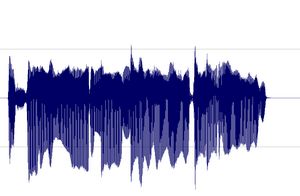
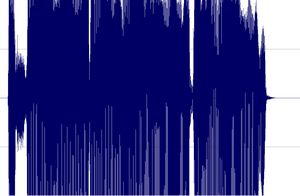
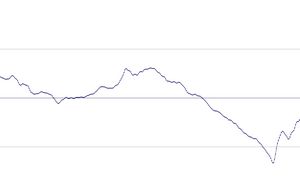
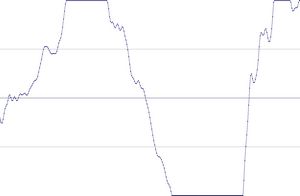

I prefer to record them last but there are no rules. If you prefer to record them first, then do so.
To record vocals, make sure the place is quiet, shut the door, tell the people who live with you to be quiet, and do not record while your neighbor is drilling holes through his kitchen walls! Also, turn off your monitors and use a headset instead to avoid recording the playback with your microphone.
Condenser or dynamic microphones?
Dynamic microphones are solid, they don' need a power source, they can take heavy acoustic pressure (like a kick drum or a saxophone) and they are not too expensive. They are also less sensitive to surrounding noises than condenser microphones. The cons are they lack clarity in the high range, which renders takes less clear and defined than with condenser microphones. They can be used with Jack or XLR plugs.
Condenser microphones are much more responsive and accurate. Their high sensitivity is double-edged, because they will capture any noise when recording. The fans of your PC are noisy? Chances are this noise will be recorded. Sound comes out of your headset? It will be recorded by your condenser microphone. Children are loudly playing outside? You might get that too. However, some condenser microphones are called "cardioid", or "hyper cardioid", and they only record what comes from a specific direction, ignoring (more or less) other sound sources from other directions. On the contrary, omnidirectional microphones record what comes from anywhere. Not ideal for a home studio. Condenser microphones are also more fragile (don't knock them) and must be powered through a "phantom power", whose standard is 48 volts. This kind of power is either present on your audio interface and can be turned on and off with a button, or it will require the use of an external phantom power source that you will then connect to your audio interface. You have to use 3-pin XLR plugs that carry the phantom power current. Finally, condenser microphones are usually rather expensive, some of them cost several thousand euros (or dollars, or pounds), but only professional studios or rich amateurs can afford those. On the plus side, the sound you get with a condenser microphone will have the best quality.
Be cautious though, a good dynamic microphone is worth better than a bad condenser microphone. No big secret here, for microphones like for anything else, very low prices are rarely synonymous with good quality.
A few known and renowned microphone brands: AKG, Milab, Neumann, Rode, Sennheiser, Shure...
Some pieces of advice: buy a microphone stand and a pop filter (you can also make one yourself with wire and a piece of tights from your wife / girlfriend / mother / daughter / neighbor). The stand will prevent you from manually holding your microphone and thus produce handling noises. As for the pop filter, it prevents the air to hit the microphone and produce unwanted blowing sounds when you pronounce some letters such as "p" or "b".
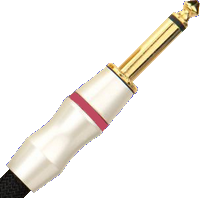
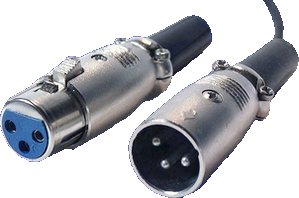
Jack plug (left) and XLR (right)
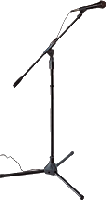


No need to go on and on forever, recording is rather easy. As long as you pay attention to your recording levels and take care over your takes, you should get a satisfying result, good enough to finalize the song

Messages page # 1 2 3 4 5 6 7 8 9 10 11 12 13 14 15 16 17 18 19 20 21 22 23 24 25 26 27 28 29 30 31 32 33 34 35

CelticBreizh
le 12/04/2010 à 22h00
Encore merci de votre réponse. Je me demande même si je ne vais pas craquer pour votre carte qui a plus de réglages en façade, laissant l'arrière aux Jacks et à l'alim.
* * * * * * * * * * * * * * * *
<em>Comme vous voulez, mais avez-vous vraiment besoin de 8 entrées ? Dont seulement 2 avec préampli (les deux à l'avant) ? À vous de voir,
Grebz</em>

CelticBreizh
le 12/04/2010 à 09h21
Bonjour,
J'envisage l'acquisition d'une nouvelle interface audio type EDIROL FA-66 et je voulais savoir ce que vous en pensiez étant donné que vous avez déjà une EDIROL FA-101, un modèle un peu semblable mis à part le nombre important d'entrées.
Ma carte Presonus me joue des tours mais je souhaiterais rester sur une connexion en firewire. Pouvez-vous me dire si c'est un bon choix ?
* * * * * * * * * * * * * * * *
<em>Bonjour Éric,
<a href="http://fr.audiofanzine.com/carte-son-externe/edirol/FA-66/avis/">Les avis sur Audiofanzine</a> sont tous très bons. Visiblement les utilisateurs sont satisfaits de leur achat. De mon côté, je suis également satisfait de ma FA-101 qui ne m'a jamais fait défaut, que j'enregistre seul chez moi en n'utilisant qu'une seule entrée, ou bien en enregistrant un groupe en live avec 8 entrées simultanées. Les préamplis de la carte ne sont pas extraordinaires, mais devraient suffire néanmoins. En cas de besoin, il sera toujours possible de leur adjoindre ultérieurement un préampli externe supplémentaire.
La connexion Firewire a l'avantage d'utiliser très peu de ressources processeur (moins qu'une connexion USB), ce qui permet de libérer ces ressources supplémentaires pour le séquenceur, d'être très stable et d'avoir une bande passante supérieure à l'USB 2.
Dans le cas de la musique, toutefois, cette dernière caractéristique n'a pas vraiment d'importance. C'est plus important dans le domaine de la vidéo.
Au niveau des défauts, la connexion Firewire nécessite l'utilisation d'une alimentation secteur lors d'une utilisation sur un portable. La prise mini-Firewire qu'on trouve sur les portables ne peut pas fournir d'alimentation électrique contrairement à l'USB. Donc, il faudra brancher l'interface sur le secteur, ce qui fait des branchements en plus. Mais pour une installation fixe, ce n'est pas trop gênant.
Les drivers de la FA-101 sont stables, ils existent en 32 et 64 bits et fonctionnent sous Windows XP, Vista et Seven. Il me semble que les drivers sont communs pour la FA-101 et la FA-66... en tout cas, les fichiers qui composent ces drivers, téléchargés sur <a href="http://www.rolandus.com/products/productdetails.php?ProductId=731">le site d'Edirol</a>, sont quasiment identiques à 2 ou 3 détails près. La FA-66 n'est de toute manière qu'une FA-101 allégée, elles doivent sortir du même moule !
Donc oui, je peux vous recommander cette interface audio. De toute façon, achetez-la et essayez-la, vous avez légalement une semaine pour vous rétracter auprès de votre vendeur.
Grebz
</em>

Jikoo
le 12/04/2010 à 01h42
Superbe page (simulateurs d'ampli) !
J'ai appris plein de choses. C'est vraiment très intéressant. Merci beaucoup et bonne continuation.
Jerry Coox - Musicien
(Facile à trouver sur le web !)
* * * * * * * * * * * * * * * *
<em>Merci à vous !
Je rajoute un lien vers <a href="http://www.myspace.com/jerrycoox" target="_blanck">votre MySpace</a>, j'ai écouté ce que vous faites, c'est vraiment très bien !
Grebz</em>

CelticBreizh
le 24/03/2010 à 20h06
Bonjour,
Merci encore de votre précédente réponse.
Pour information, voila ce que j'ai relevé sur mon portable ACER :
Avant tout, j'ai pensé à ce portable parce qu'il est silencieux. Je ne dispose pas d'une pièce dédiée et suis en fauteuil roulant. Ce n'est pas toujours simple pour tous les branchements. Dans la MAO, je cherche juste à mettre de la musique, piste à piste, derrière mes textes. Alors maintenant mon ordinateur portable, c'est :
Modèle Aspire type 5670 / 5673 WLMi
Processeur : Intel Core Duo T2400 (1.83 GHz, 667 MHz FSB, 2MB L2 cache)
En fait, c'est un Intel Centrino Duo destiné plus particulièrement aux portables.
L'écran est un 15.4 pouces WXGA. C'est un peu petit pour y caser le séquenceur, la table de mixage, les VST et VSTi etc... ça finit par être complètement brouillon. Je sais qu'il me faut un autre écran (d'ailleurs mon portable peut l'accepter). Le séquenceur d'un côté et de l'autre, le mix et tous le reste. Ce serait plus clair. J'envisage effectivement l'achat d'un 24 ou 26 pouces.
La vidéo, c'est bien sûr de l'intégré, ATI Mobility Radeon X 1600
Le disque dur : 120 GB SATA partitionné. J'ai un disque dur externe Western Digital Caviar d'1To acheté récemment.
La mémoire : 2 Go DDR2 (support dual channel).
C'est sans doute là que ça pêche le plus, avec 2 Go et mon processeur centrino, je vais vite atteindre les limites si j'utilise beaucoup de VST ou VSTi.
Un petit plus, j'ai une prise FireWire sur laquelle je branche ma carte son externe Presonus Fire Box.
Je n'ai pas encore de préampli mais j'envisage d'en acheter un. Un petit et modeste appareil, je n'ai ni les prétentions, ni les moyens d'un studio professionnel.
J'ai repéré chez Thomann en Allemagne un ART TUBE MP à 38€. Ce sera sans doute mieux que rien vu que je n'en utilisais pas avant. Ça me fait 2 alim de 48 Volts pour mon micro statique SAMSON.
Par contre, j'utilise un EDIROL PCR - A30 et là, j'ai sans doute encore mal choisi puisqu'apparemment il serait doté d'une Audio Interface, cette interface n'était sans doute pas nécessaire puisque j'avais déjà une carte son PRESONUS ???
Ce clavier se branche en USB mais est aussi doté d'un transfo, c'est peut-être plus stable, je ne sais pas.
Les infos relevées sur ce clavier : EDIROL PCR - A30 - ROLAND, 24 Bit 96 kHz Digital Audio, USB Audio Interface, Midi Key Board Controller.
Je sais que l'on peut contrôler certaines fonctions mais j'avoue que je ne l'utilise que comme un clavier midi. Je suis loin d'en tirer le maximum.
Un ami me l'avait conseillé mais maintenant, je ne sais pas si c'est un bon choix.
Et pour finir, je suis sous XP, et j'aimerais le rester.
C'est un portable que je veux remettre à plat en formatant et en le consacrant uniquement au son et rien d'autre.
La connexion Internet (pour les mises à jour windows) sera coupée pendant le travail sous Cubase, de même qu'Avast, mon antivirus. J'espère ainsi alléger le système. Il n'y aura même pas de messagerie.
Au fait, comment fait-on pour geler des pistes ?
Je suis preneur de tous conseils. D'avance merci.
CelticBreizh

CelticBreizh
le 24/03/2010 à 01h45
Bonjour,
Un excellent site qui permet de s'y retrouver facilement dans la MAO.
Avant de trouver des séquenceurs "non limités", j'avais investi dans bon nombre de matériels, tables de mixage, racks en tous genres dont compresseur, ampli casques, microverb Alesis etc... tout en analogique bien entendu. Certaines tables de mixage étaient dotées d'une alim phantom pour mon micro statique, d'où cet achat que je regrette maintenant compte tenu des possibilités des petites cartes son externes bien suffisantes à mon goût (ma presonus gère le 48V). Quand Cubase a pu gérer correctement l'audio et pas seulement le midi, j'ai soigneusement rangé tout ce matériel. Pour un temps, j'ai continué à me servir de ma table de mixage mais, l'encombrement fait que je vais me résoudre à utiliser le mix du séquenceur mais l'écran d'un portable n'est pas extensible et cela devient vite un casse tête d'ouvrir toutes ces fenêtres à l'écran et avoir constamment la main sur la souris. Mon portable n'a que 2 Go de ram, j'espère qu'il ne plantera pas durant les enregistrements que je faisais avant sur un fixe assemblé par mes soins. Pourquoi alors ce portable ? Moins de bruit, moins d'encombrement, moins de fils. Bien que vieux de 4 ans, son processeur est un double-coeur. Je vais lui adjoindre un disque dur externe et j'espère que cela suffira pour mes compos. Si vous pouviez me donner votre avis éclairé sur mon modeste matériel, merci d'avance.
En tous cas, bravo pour les sujets abordés, ça a le mérite d'être clair alors que d'autres auraient traité cela de façon ultra technique sans que je puisse m'y retrouver.
À bientôt. Éric
* * * * * * * * * * * * * * * *
<em>Bonjour Éric,
Tout d'abord merci de votre message sur mon site, ça fait plaisir de voir que je peux rendre service à quelqu'un. Si je fais cela, c'est parce que moi-même, j'ai pas mal galéré en me lançant dans la MAO voici quelques années et que j'ai eu du mal à m'y retrouver face à toutes ces notions déroutantes au départ. Je ne suis pas devenu un spécialiste pour autant, mais j'ai appris suffisamment pour essayer d'aider à mon tour, dans un langage que j'espère accessible au plus grand nombre, sans verser non plus dans l'abêtissement. Il faut parfois appeler un chat un chat (ou un compresseur un compresseur) pour éviter les dérives de langage qui perdent tout le monde... Bref.
En ce qui concerne votre matériel analogique, je ne sais pas s'il faut regretter de l'avoir acheté. J'imagine que financièrement, ça représente un investissement et qu'il est toujours dommage de s'apercevoir au bout de quelques temps qu'on n'a pas forcément fait le bon choix, mais malheureusement, dans les domaines "techniques" (informatique, musique, vidéo...), il sort constamment de nouveaux équipements qui supplantent les anciens et si on attend le bon moment... on ne se lance jamais ! Après, il y a l'encombrement qui peut également poser problème. Mais l'analogique a aussi des qualités : le son (évidemment, tout dépend du matériel), et la manipulation physique, plus naturelle à l'usage qu'une souris. Mais tout est question d'habitude.
Pour ce qui est de votre matériel actuel, un portable, vous avez vous-même parlé de ses limites : la taille de l'écran qui fait qu'on se sent vite à l'étroit, et le fait qu'il soit déjà un peu ancien (en termes informatiques bien entendu).
Pour l'écran, il vous est toujours possible de lui adjoindre un écran plat si vous disposez de la place suffisante, et du budget bien entendu. Un bon écran plat de bonne taille (disons 24 ou pourquoi pas, soyons fou, 26 pouces !) ajoutera beaucoup de confort pour un tarif à situer entre 200 et 300 euros selon la marque et la qualité attendue. Non négligeable, mais très confortable. Il est même possible de disposer ainsi d'un double écran, sur le portable et sur l'écran supplémentaire, à condition que la carte graphique du portable gère cette fonctionnalité, ce qui est bien souvent le cas.
Avoir un processeur dual-core est un avantage évident, tout dépend cependant du processeur en question. Certains dual-core un peu anciens ne sont pas très puissants, rien ne remplace un bon test par soi-même pour tester les limites de la machine.
J'utilise moi-même un portable de marque ASUS. Je l'ai acheté voici bientôt 3 ans, il a également un processeur dual-core à 2,5 GHz et 3 Go de mémoire. Fourni à l'origine avec Windows Vista, je l'ai remplacé récemment par Windows 7 en version 64 bits.
Voilà ce que je peux vous dire de mon expérience avec ce portable pour une utilisation musicale :
Déjà, je ne l'utilise pour la musique qu'en déplacement, puisque j'utilise normalement mon ordinateur de bureau, bien plus puissant. Ce que j'ai constaté, c'est qu'il réagit mieux lorsque j'utilise mon séquenceur Sonar en version 32 bits qu'en version 64 bits. j'ai installé les 2 versions et cette dernière est plus lourde semble-t-il. C'est en tout cas mon ressenti.
Hormis cela, aucun souci pour enregistrer. J'ai déjà enregistré plusieurs fois des concerts live, avec parfois jusqu'à 8 pistes simultanément, pour un enregistrement sans interruption pendant un peu moins de 3 heures. Ni le disque dur, ni le processeur (très peu sollicité par l'enregistrement) n'ont montré de signes de faiblesse. Le disque dur est pourtant un simple disque à 5400 tours par minute, donc pas franchement un foudre de guerre.
J'ai également enregistré une pièce de théâtre amateur en branchant simultanément une carte son USB et un caméscope FireWire et donc en enregistrant 2 pistes audio sur sonar, pendant que la vidéo s'enregistrait (sur le même disque dur) via un logiciel de montage. Toujours sans souci.
En fait, je trouve les limites de mon ordinateur portable lors de l'utilisation de plugins VST ou d'instruments VSTi. Là, je constate une nette différence avec mon PC de bureau. Mon processeur de portable sature bien plus vite. Mais j'avoue que j'utilise pas mal de plugins, parfois plusieurs dizaines sur un projet. La seule solution dans ce cas est de "geler" les pistes, de façon à libérer le processeur. Si vous utilisez peu de VST, il ne devrait pas y avoir de problème, mais dans le cas contraire, attendez-vous à rencontrer des ralentissements, voire des interruptions de lecture. Et lors d'enregistrements, désactivez les plugins inutiles pour soulager le processeur.
Quant aux 2 Go de mémoire, c'est peut-être un peu juste avec Windows Vista, mais cela devrait suffire pour XP ou Windows 7. Sachez qu'avec un 32 bits, Windows ne laisse pas plus de 3 à 3,5 Go de mémoire disponible pour l'utilisateur, et que chaque application ne peut disposer que de 2 Go au maximum. Le système lui-même va consommer une partie variable de la mémoire selon les applications et services installés.
C'est l'intérêt d'un système en 64 bits : à condition que le processeur le gère, un système 64 bits va pouvoir utiliser l'intégralité de la mémoire à sa disposition, et les applications 64 bits ne seront pas limitées non plus. Mais un logiciel 32 bits sur un système 64 bits sera toujours limité à 2 Go. Pour aller au-delà, il faut que le logiciel soit lui-même programmé en 64 bits.
Voilà ce que je peux vous dire. Musicalement vôtre,
Grebz</em>
* * * * * * * * * * * * * * * *
Merci d'avoir pris le temps de me répondre. ça me semble si clair maintenant. Un grand merci et encore bravo pour votre site.
Éric
